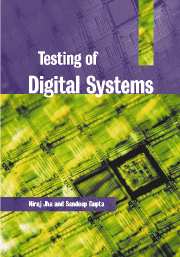Book contents
- Frontmatter
- Contents
- Preface
- List of gate symbols
- 1 Introduction
- 2 Fault models
- 3 Combinational logic and fault simulation
- 4 Test generation for combinational circuits
- 5 Sequential ATPG
- 6 IDDQ testing
- 7 Functional testing
- 8 Delay fault testing
- 9 CMOS testing
- 10 Fault diagnosis
- 11 Design for testability
- 12 Built-in self-test
- 13 Synthesis for testability
- 14 Memory testing
- 15 High-level test synthesis
- 16 System-on-a-chip test synthesis
- Index
12 - Built-in self-test
Published online by Cambridge University Press: 05 June 2012
- Frontmatter
- Contents
- Preface
- List of gate symbols
- 1 Introduction
- 2 Fault models
- 3 Combinational logic and fault simulation
- 4 Test generation for combinational circuits
- 5 Sequential ATPG
- 6 IDDQ testing
- 7 Functional testing
- 8 Delay fault testing
- 9 CMOS testing
- 10 Fault diagnosis
- 11 Design for testability
- 12 Built-in self-test
- 13 Synthesis for testability
- 14 Memory testing
- 15 High-level test synthesis
- 16 System-on-a-chip test synthesis
- Index
Summary
In this chapter, we discuss built-in self-test (BIST) of digital circuits. We begin with a description of the commonly used test pattern generators, namely linear feedback shift-registers and cellular automata, and the properties of sequences they generate. This is followed by an analysis of test length vs. fault coverage for testing using random and pseudo-random sequences. Two alternative approaches are then presented to achieve the desired fault coverage for circuits under test (CUTs) for which the above test pattern generators fail to provide adequate coverage under given constraints on test length. We then discuss various test response compression techniques, followed by an analysis of the effectiveness of commonly used linear compression techniques.
The second part of the chapter focuses on issues involved in making a large digital circuit self-testable. We begin with a discussion of some of the key issues and descriptions of reconfigurable circuitry used to make circuits self-testable in an economical fashion. We then discuss two main types of self-test methodologies, in-situ BIST and scan-based BIST, followed by more detailed descriptions of the two methodologies in the last two sections.
The third part of the chapter contains description of BIST techniques for delay fault testing as well as for testing with reduced switching activity.
Introduction
Built-in self-test refers to techniques and circuit configurations that enable a chip to test itself. In this methodology, test patterns are generated and test responses are analyzed on-chip.
- Type
- Chapter
- Information
- Testing of Digital Systems , pp. 680 - 798Publisher: Cambridge University PressPrint publication year: 2003

